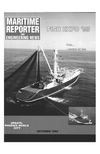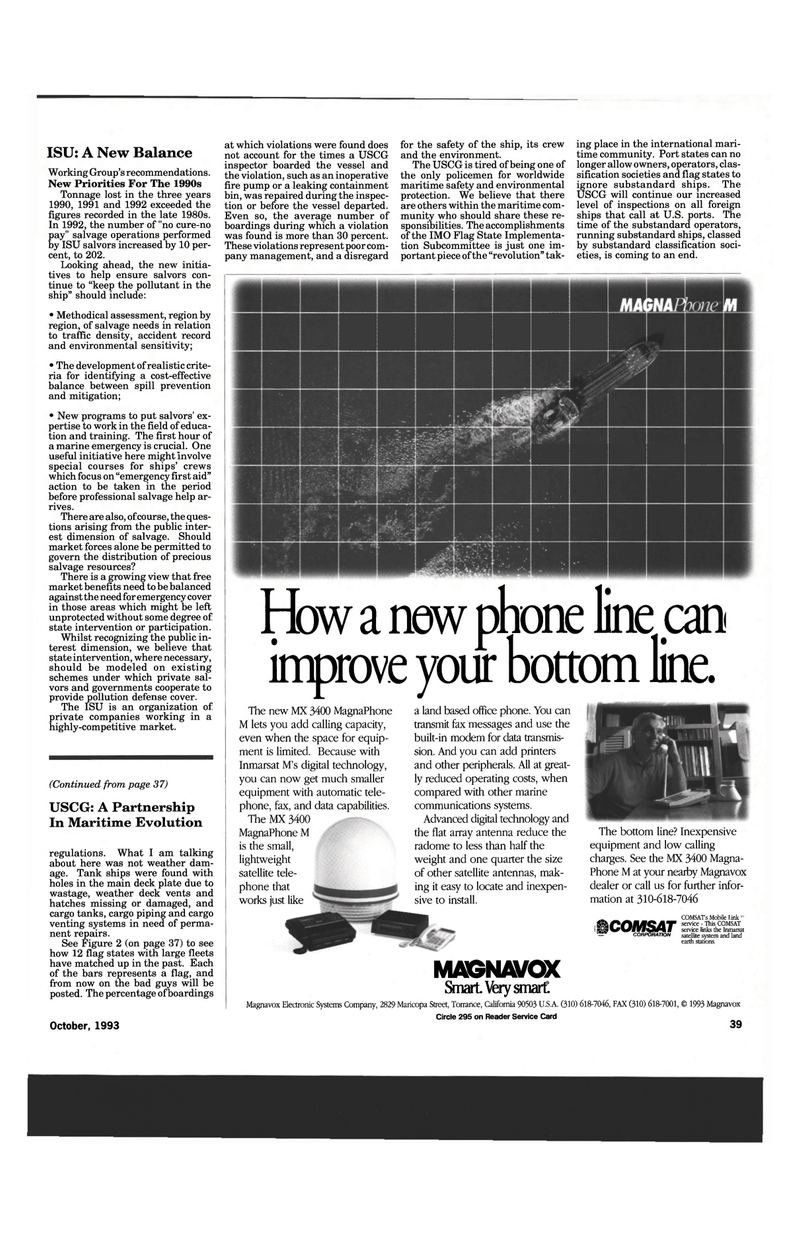
Page 37: of Maritime Reporter Magazine (October 1993)
Read this page in Pdf, Flash or Html5 edition of October 1993 Maritime Reporter Magazine
ISU: A New Balance
Working Group's recommendations.
New Priorities For The 1990s
Tonnage lost in the three years 1990, 1991 and 1992 exceeded the figures recorded in the late 1980s.
In 1992, the number of "no cure-no pay" salvage operations performed by ISU salvors increased by 10 per- cent, to 202.
Looking ahead, the new initia- tives to help ensure salvors con- tinue to "keep the pollutant in the ship" should include: • Methodical assessment, region by region, of salvage needs in relation to traffic density, accident record and environmental sensitivity; • The development of realistic crite- ria for identifying a cost-effective balance between spill prevention and mitigation; • New programs to put salvors' ex- pertise to work in the field of educa- tion and training. The first hour of a marine emergency is crucial. One useful initiative here might involve special courses for ships' crews which focus on "emergency first aid" action to be taken in the period before professional salvage help ar- rives.
There are also, of course, the ques- tions arising from the public inter- est dimension of salvage. Should market forces alone be permitted to govern the distribution of precious salvage resources?
There is a growing view that free market benefits need to be balanced against the need for emergency cover in those areas which might be left unprotected without some degree of state intervention or participation.
Whilst recognizing the public in- terest dimension, we believe that state intervention, where necessary, should be modeled on existing schemes under which private sal- vors and governments cooperate to provide pollution defense cover.
The ISU is an organization of private companies working in a highly-competitive market. (Continued from page 37)
USCG: A Partnership
In Maritime Evolution regulations. What I am talking about here was not weather dam- age. Tank ships were found with holes in the main deck plate due to wastage, weather deck vents and hatches missing or damaged, and cargo tanks, cargo piping and cargo venting systems in need of perma- nent repairs.
See Figure 2 (on page 37) to see how 12 flag states with large fleets have matched up in the past. Each of the bars represents a flag, and from now on the bad guys will be posted. The percentage of boardings
October, 1993 at which violations were found does not account for the times a USCG inspector boarded the vessel and the violation, such as an inoperative fire pump or a leaking containment bin, was repaired during the inspec- tion or before the vessel departed.
Even so, the average number of boardings during which a violation was found is more than 30 percent.
These violations represent poor com- pany management, and a disregard for the safety of the ship, its crew and the environment.
The USCG is tired of being one of the only policemen for worldwide maritime safety and environmental protection. We believe that there are others within the maritime com- munity who should share these re- sponsibilities. The accomplishments of the IMO Flag State Implementa- tion Subcommittee is just one im- portant piece of the "revolution" tak- ing place in the international mari- time community. Port states can no longer allow owners, operators, clas- sification societies and flag states to ignore substandard ships. The
USCG will continue our increased level of inspections on all foreign ships that call at U.S. ports. The time of the substandard operators, running substandard ships, classed by substandard classification soci- eties, is coming to an end. mCOMSAT
CORPORATION
COMSAT'S Mobile Link service - This COMSAT service links the Inmarsat satellite system and land earth stations.
MAGNAVOX
Smart Very smart
Magnavox Electronic Systems Company, 2829 Maricopa Street, Torrance, California 90503 U.S.A. (310) 618-7046, FAX (310) 618-7001, © 1993 Magnavox
Circle 295 on Reader Service Card 39
How a new phone line can improve your bottom line.
The new MX 3400 MagnaPhone
M lets you add calling capacity, even when the space for equip- ment is limited. Because with
Inmarsat M's digital technology, you can now get much smaller equipment with automatic tele- phone, fax, and data capabilities.
The MX 3400
MagnaPhoneM is the small, lightweight satellite tele- phone that works just like a land based office phone. You can transmit fax messages and use the built-in modem for data transmis- sion. And you can add printers and other peripherals. All at great- ly reduced operating costs, when compared with other marine communications systems.
Advanced digital technology and the flat array antenna reduce the radome to less than half the weight and one quarter the size of other satellite antennas, mak- ing it easy to locate and inexpen- sive to install.
The bottom line? Inexpensive equipment and low calling charges. See the MK 3400 Magna-
Phone M at your nearby Magnavox dealer or call us for further infor- mation at 310-618-7046

 36
36

 38
38
